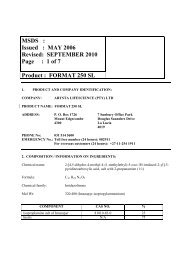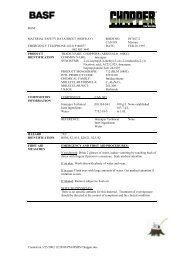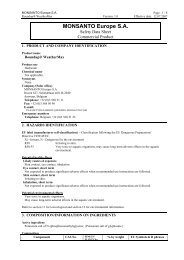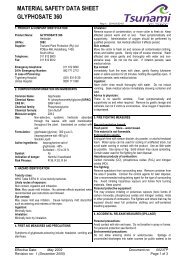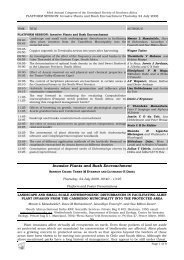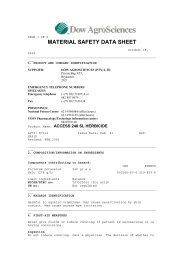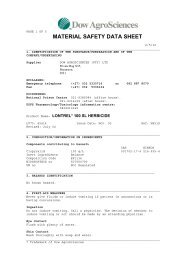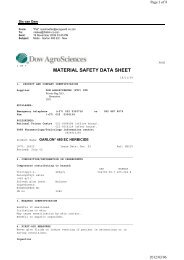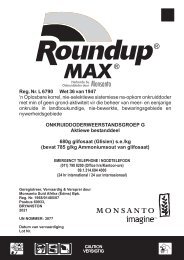MSDS - MSMA 720 SL.pdf - Bush Encroachment
MSDS - MSMA 720 SL.pdf - Bush Encroachment
MSDS - MSMA 720 SL.pdf - Bush Encroachment
Create successful ePaper yourself
Turn your PDF publications into a flip-book with our unique Google optimized e-Paper software.
MATERIAL SAFETY DATA SHEET<br />
SUBJECT:<br />
<strong>MSMA</strong> <strong>720</strong> <strong>SL</strong><br />
DOCUMENT NO: PS 057<br />
EFFECTIVE DATE: AUGUST 1997<br />
REVISION DATE: FEBRUARY 2001<br />
REVISION NO: 3<br />
PAGE: 2 of 4<br />
PRODUCT CODE: -<br />
Extinguishing agents:<br />
Small fires: Extinguish with carbon dioxide, dry powder,<br />
halon or alcohol-resistant foam.<br />
Large fires: Carbon dioxide, dry powder, halon or alcoholresistant<br />
foam. Water spray or fog can be used for or cooling<br />
of unaffected stock, but avoid the accumulation of polluted<br />
run-off from the site.<br />
Remove container from fire area if possible. Contain fire<br />
control water for later disposal. Use a recommended<br />
extinguishing agent for the type of surrounding fire.<br />
Avoid inhaling hazardous vapours. Keep material away from<br />
water sources and sewers. Do not touch material and avoid<br />
breathing fumes. Keep upwind.<br />
Special hazards:<br />
Fire may produce irritating or poisonous vapours<br />
(arsenicoxides and oxides of sodium), mists or other products<br />
of combustion.<br />
Personal protective equipment:<br />
Fire-fighters and others that may be exposed should wear full<br />
protective clothing and self-contained breathing apparatus.<br />
6. ACCIDENTAL RELEASE MEASURES<br />
(SPILLAGE)<br />
Personal precautions:<br />
Avoid contact with skin and eyes. Do not inhale fumes. For<br />
personal protection see Section 8. In view of the toxicity<br />
induced in experimental animals on repeated exposure, proper<br />
care should be taken during occupational use to avoid<br />
ingestion of spray particles, and to prevent accidental<br />
contamination of food products and water.<br />
Environmental precautions:<br />
Do not allow to enter drains or water courses. When the<br />
product contaminates public waters, inform appropriate<br />
authorities in accordance with local regulations.<br />
Occupational spill: For small liquid spills, soak up with sand<br />
or other suitable noncombustible absorbent material, such as<br />
sawdust, and place into containers for subsequent disposal.<br />
For large spills, contain liquid far ahead of spill. Contain<br />
spillage and contaminated water for subsequent disposal. Do<br />
not flush spilled material into drains. Keep spectators away.<br />
7. HANDLING AND STORAGE REQUIREMENTS<br />
Handling:<br />
Harmful if swallowed. Avoid contact with eyes, prolonged<br />
contact with skin, and inhalation of fumes or spray mist. Use<br />
with adequate ventilation. Wash hands before eating, drinking,<br />
chewing gum, smoking, or using the toilet. Remove clothing<br />
immediately if the herbicide gets inside. Then wash skin<br />
thoroughly using a non-abrasive soap and put on clean<br />
clothing. Do not apply directly to areas where surface water is<br />
present, or to intertidal areas below the mean high water mark.<br />
Water used to clean equipment must be disposed of correctly to<br />
avoid contamination.<br />
Storage:<br />
Store in its original labeled container in a shaded, wellventilated<br />
area, away from heat, sparks and other sources of<br />
ignition. Not to be stored next to foodstuffs and water<br />
supplies. Keep out of reach of children and animals. Local<br />
regulations should be complied with.<br />
8. EXPOSURE CONTROL / PERSONAL<br />
PROTECTION<br />
Occupational exposure limits:<br />
TLV (as As): 0.2 ppm; mg/m 3 (ACGIH 1991-1992)<br />
Engineering control measures:<br />
It is essential to provide adequate ventilation. The measures<br />
appropriate for a particular work site depend on how this<br />
material is used and on the extent of exposure. Ensure that<br />
control systems are properly designed and maintained. Comply<br />
with occupational safety, environmental, fire, and other<br />
applicable regulations. If engineering controls and work<br />
practices are not effective in controlling exposure to this<br />
material, then wear suitable personal protective equipment<br />
including approved respiratory protection.<br />
Respirator:<br />
An approved respirator suitable for protection from spray mists<br />
of pesticides is adequate. Limitations of respirator use<br />
specified by the approving agency and the manufacturer must<br />
be observed.<br />
Clothing:<br />
Employee must wear appropriate protective (impervious)<br />
clothing and equipment to prevent repeated or prolonged skin<br />
contact with this substance.<br />
Gloves:<br />
Employee must wear appropriate synthetic protective gloves to<br />
prevent contact with this substance.<br />
Eye protection:<br />
The use of safety goggles is recommended.<br />
Emergency eye wash: Where there is any possibility that an<br />
employee’s eyes may be exposed to this substance, the<br />
employer should provide an eye wash fountain or appropriate<br />
alternative within the immediate work area for emergency use.



